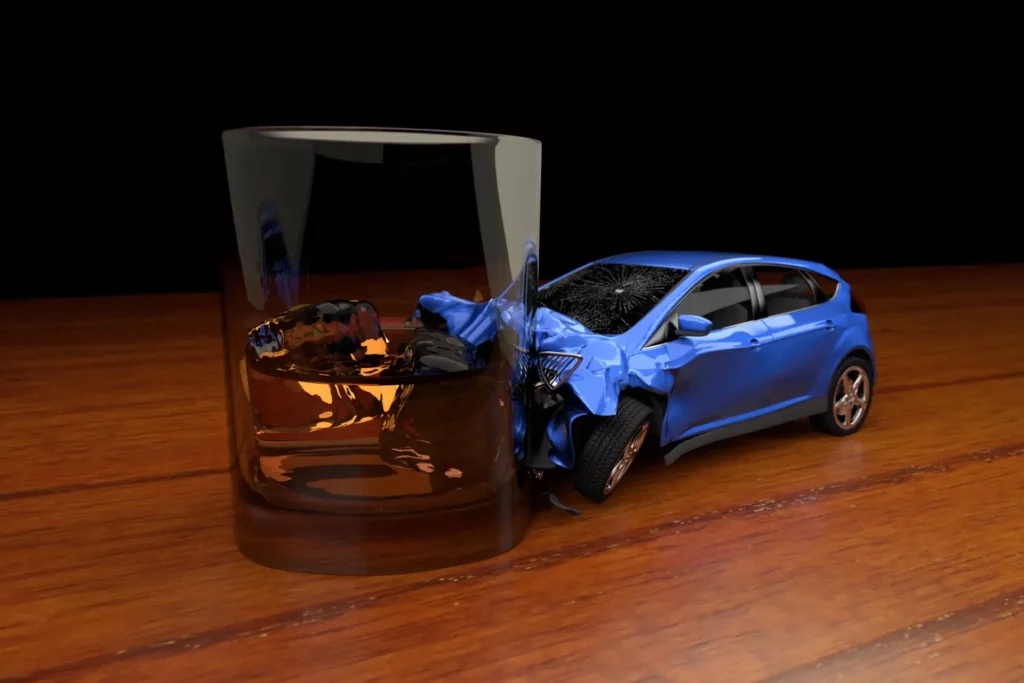The United States is facing a serious and ongoing problem with drunk driving, which poses a significant danger to road safety.
Shockingly, statistics show that almost 30 people lose their lives each day as a result of alcohol-impaired driving.
Even more concerning, there has been an increase in the number of alcohol-related driving fatalities each year.
In this article, we will take a closer look at these statistics and explore potential measures that could help to reduce this deadly trend.
Recent Data and Statistics on Drunk Driving
| Statistic | Details |
|---|---|
| Ride-sharing impact on alcohol-related fatalities | Ride-sharing has decreased alcohol-related US traffic fatalities by 6.1% and reduced overall US traffic deaths by 4%. (National Bureau of Economic Research) |
| Daily alcohol-impaired driving deaths in 2023 | As of 2023, every day, 37 people in the United States die in car crashes with an alcohol-impaired driver. This is one death every 39 minutes. (CDC) |
| Percentage of traffic deaths due to alcohol impairment | More than a quarter (31%) of all traffic-related deaths are the direct result of alcohol impairment. (NHTSA) |
| Drunk driving deaths in 2021 | There were 13,384 deaths from drunk driving crashes in 2021. (NHTSA) |
| 10-year average of drunk driving deaths | Over the 10-year period from 2011 to 2021, there were on average 11,000 deaths a year due to drunk driving. |
| Teen involvement in drunk driving | 1 in 4 crashes with teens involve an underage drunk driver (Mothers Against Drunk Driving) |
| Risk of fatal accident with high BAC | Drivers with a Blood Alcohol Content of over 0.10 are 7 times more likely to be involved in a fatal accident than sober drivers. (Responsibility.org) |
| Annual drunk driving deaths, including children | Over 10,000 Americans a year are killed by drunk drivers, about 1,000 of them being children. (CDC) |
The Science of Impairment
The consumption of alcohol can have a significant impact on the human body and its ability to carry out complex tasks, such as driving.
Once consumed, alcohol enters the bloodstream and affects the central nervous system, causing impairments to cognitive functions and motor skills.
This can lead to a slower ability to process information, a delayed reaction time to unexpected events on the road, compromised judgment, coordination, and perception of distance and speed.
In addition, alcohol can create a false sense of confidence, causing drivers to underestimate their level of impairment and take greater risks.
As the blood alcohol concentration (BAC) increases, these effects become more pronounced, making drunk driving a severe hazard not only to the driver but to other road users as well.
WHAT IS BAC AND HOW DOES IT WORK?
Blood Alcohol Concentration (BAC) is a crucial metric used to determine the amount of alcohol present in an individual’s bloodstream, and it plays a significant role in assessing driving impairment.1
Expressed as a percentage, BAC indicates the grams of alcohol per 100 milliliters of blood.
As BAC levels rise, the negative effects on cognitive and motor skills intensify.
For instance, even at a BAC of 0.02%, an individual may experience a decline in visual functions and multitasking capability.
By the time the BAC reaches 0.08%—the legal limit for driving in many jurisdictions—the risk of a crash increases exponentially due to severely impaired judgment, coordination, and reaction times.
BAC is typically measured using breathalyzers, devices that assess the amount of alcohol in one’s breath and then calculate the estimated concentration in the blood.
Another more direct but less commonly used method involves drawing blood for analysis.
Both methods aim to provide an objective measure of intoxication and potential impairment.
The Cold Numbers
In 2021, there was a significant increase in fatalities resulting from drunk-driving crashes on American roads, highlighting the devastating impact of alcohol-impaired driving.
Statistics show that roughly 31% of all road fatalities in the US involve drivers with blood alcohol content (BAC) levels measuring .08 g/dL or higher.
In 2021, the number of deaths resulting from these avoidable accidents reached 13,384.
The data from 2012 to 2021 also shows a consistent and alarming trend: almost 10,850 people lost their lives annually due to drunk-driving incidents.2
These statistics reveal a concerning trend that requires immediate attention.
Notably, a considerable portion of these crashes involved drivers with Blood Alcohol
Concentrations (BAC) below the legal limit of 0.08 g/dL, emphasizing that even low levels of alcohol can impair driving and lead to fatal outcomes.
The data also shows that certain age groups, particularly young adults between the ages of 21 and 34, and motorcyclists, were more vulnerable to drunk-driving incidents.
It’s important to remember that driving under the influence is illegal in every state in the US.
Despite this, an unsettling statistic from 2021 reveals that one person loses their life in a drunk-driving accident every 39 minutes.
The Legal Consequences
In the United States, laws against driving under the influence (DUI) aim to discourage and penalize driving while impaired by alcohol.
It is against the law in every state to drive with a Blood Alcohol Concentration (BAC) of 0.08% g/dL or higher.
There are more stringent limits for commercial drivers and those who are under the legal drinking age.
Penalties for DUI often include fines, jail time, license suspension, and mandatory alcohol education or treatment programs.
However, some states have introduced even stricter regulations.
Utah is a prime example, as it lowered the legal BAC limit to 0.05% g/dL in 2018.3
This change was driven by the recognition that even low BAC levels can cause impairment.
Additionally, many states have zero-tolerance laws for drivers under 21, which means that any detectable amount of alcohol can lead to DUI charges.
As DUI incidents and their consequences remain a concern, states continually assess and adjust their laws to better protect the public.
PENALTIES FOR DRIVING WHILE IMPAIRED
Driving while impaired is a serious offense that poses a threat to public safety.
Penalties for this type of behavior aim to discourage individuals from driving under the influence and to safeguard the public.
The punishment system for this offense is multi-tiered, and it varies depending on the severity of the crime and any prior DUI convictions.
For first-time offenders, the penalties include hefty fines ranging from a few hundred to several thousand dollars, a mandatory suspension of their driver’s license for a specific period, and mandatory attendance of DUI school or alcohol assessment and treatment.
The severity of the punishment increases as the gravity of the offense increases, particularly for repeat offenders, those with higher BAC levels, or those whose impaired driving causes injury or death.
The penalties can include longer license suspensions, installation of an ignition interlock device, community service, probation, and significant jail or prison time.
The goal of these penalties is to emphasize the seriousness of impaired driving and discourage repeat offenders.
IGNITION INTERLOCK DEVICES
As a preventative measure against drunk driving, ignition interlock devices (IIDs) are a technological intervention that require drivers with a history of impaired driving to take a breathalyzer test before starting their vehicle.
The device detects if there is any alcohol in the driver’s system above a predetermined level, preventing them from starting the vehicle.
IIDs have been proven to be highly effective, reducing repeat offenses by 50-90% depending on the jurisdiction and specific conditions of use.
Therefore, many states mandate or encourage their installation for individuals convicted of DUI, particularly repeat offenders.
IIDs not only act as a deterrent but also as a rehabilitation tool by training drivers to separate drinking from driving, ultimately promoting safer roadways for everyone.
The Economic Impact
Getting arrested for a first-time DUI can be costly for the offender.
In addition to court fees, which vary depending on where you live, you may also be required to pay towing and storage fees, bail, attorney fees, and the cost of alcohol education or treatment programs.
If an ignition interlock device is required, you’ll also have to pay installation and monthly service fees.
All of these expenses can add up to several thousand dollars, not including any lost wages if you need to take time off work.
Drunk driving also has a significant impact on society as a whole.
Emergency services respond to crashes, medical care is needed for those who are injured, and legal proceedings can be costly.
Additionally, prolonged therapy or rehabilitation may be required.
The loss of productivity from injured individuals or those who lose their lives also affects the economy.
These societal costs highlight the importance of preventing DUIs and the negative impact of alcohol-impaired driving.
Drugs and Medication: The Double Whammy
When alcohol is combined with other substances or medications, the risks of driving impaired increase significantly.
Many drugs, whether prescribed, over-the-counter, or illicit, can intensify the cognitive and motor impairments caused by alcohol.
For example, sedatives can enhance drowsiness when mixed with alcohol, and stimulants can mask certain signs of intoxication while still severely impairing judgment and coordination.
Additionally, some medications can unpredictably interact with alcohol, resulting in exacerbated side effects or new impairments that seriously compromise driving ability.
It’s worth noting that drug-impaired driving, even without alcohol, is becoming a more recognized issue.
Like alcohol, various drugs can hinder judgment, reaction time, motor skills, and coordination, making driving a dangerous activity.
This growing concern highlights the need for awareness of not just drunk driving, but also the broader issue of substance-impaired driving.
Risk Factors
When it comes to drunk driving, certain demographics and behaviors have been found to increase the likelihood of such incidents.
Age is a significant factor, with drivers between the ages of 21 to 34 having higher statistics of being involved in alcohol-related crashes.
Additionally, individuals with a history of alcohol abuse or dependence are also at a greater risk of repeated DUI offenses.
Other risk factors include a history of binge drinking, previous DUI convictions, and certain mental health conditions or behavioral patterns.
It’s crucial to recognize these risk factors and implement targeted intervention strategies to address them.
By doing so, preventive measures can be more effectively catered to those at heightened risk.
Preventative Measures
To prevent drunk driving and ensure road safety, taking preventative measures is crucial.
Responsible behavior is the first line of defense, such as designating a sober driver, using rideshare services or taxis, or choosing to stay overnight if alcohol has been consumed.
It’s also essential to be proactive by preventing friends or family members from driving drunk and being a designated driver when necessary.
Educational campaigns play a significant role in raising awareness about the dangers of drunk driving.
Programs like “Drive Sober or Get Pulled Over” and “Every 15 Minutes” aim to educate the public and provoke thoughtful reflection on the consequences of impaired driving.
Schools and communities often participate in these campaigns, reinforcing the message through real-life simulations, testimonials, and other impactful methods.
The combination of individual responsibility and broader educational efforts is crucial to reducing the prevalence and tragic outcomes of drunk driving.
The Role of Technology
With the advancement of technology, preventing drunk driving has become easier and more effective.
Ride-sharing platforms like Uber and Lyft have revolutionized transportation by offering a safe and affordable option for those who are intoxicated.
These apps have contributed to the decrease in DUI incidents by providing sober drivers at the touch of a button.
Additionally, vehicular safety technologies have improved, providing an extra layer of protection.
Advanced driver-assistance systems, such as automatic emergency braking and lane-keeping assist, can help reduce the risks caused by impaired drivers.
Future innovations are exploring the possibility of integrating systems that can detect driver impairment and take appropriate action, such as alerting the driver or limiting the vehicle’s functionality.
These technological advancements give hope for significantly reducing the dangers and prevalence of drunk driving.
If you or a loved one is struggling with Alcohol Addiction, please reach out to Cornerstone Healing Center in Scottsdale, AZ.
We use a holistic approach to address mind, body, and spirit for long-term recovery.
Let us help you today!





